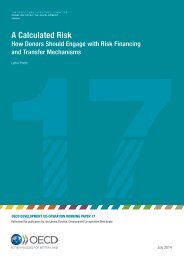UNIVERSITY
Livelihood_resilience_working_paper22
Livelihood_resilience_working_paper22
You also want an ePaper? Increase the reach of your titles
YUMPU automatically turns print PDFs into web optimized ePapers that Google loves.
core of human lives includes the universal and culturally specific, material and non-‐material <br />
elements necessary for people to act on behalf of their interests and to live with dignity” (Glossary, <br />
IPCC WG2 AR5 2014). <br />
Industrialized/developed/developing countries: “There are a diversity of approaches for <br />
categorizing countries on the basis of their level of development, and for defining terms such as <br />
industrialized, developed, or developing. Several categorizations are used in this report. In the <br />
United Nations system, there is no established convention for the designation of developed and <br />
developing countries or areas. The United Nations Statistics Division specifies developed and <br />
developing regions based on common practice. In addition, specific countries are designated as least <br />
developed countries, landlocked developing countries, small island developing states, and transition <br />
economies. Many countries appear in more than one of these categories. The World Bank uses <br />
income as the main criterion for classifying countries as low, lower middle, upper middle, and high <br />
income. The UNDP aggregates indicators for life expectancy, educational attainment, and income <br />
into a single composite human development index (HDI) to classify countries as low, medium, high, <br />
or very high human development” (Glossary, IPCC WG2 AR5 2014). <br />
Livelihood: “The resources used and the activities undertaken in order to live. Livelihoods are usually <br />
determined by the entitlements and assets to which people have access. Such assets can be <br />
categorized as human, social, natural, physical, or financial” (Glossary, IPCC WG2 AR5 2014). <br />
Livelihood resilience: “The capacity of all people across generations to sustain and improve their <br />
livelihood opportunities and wellbeing despite environmental, economic, social and political <br />
disturbances” (Tanner el al. 2015). <br />
Livelihood system: “An open system, interfacing with other systems and using various resources and <br />
assets to produce livelihood, with the household as the locus of livelihood generation” (Niehof <br />
2004). <br />
Loss and Damage: Although there is no universally agreed definition, loss and damage generally <br />
refers “the adverse effects of climate-‐related stressors that have not been or cannot be avoided <br />
through mitigation and adaptation efforts” (van der Geest & Warner 2015). For assessing loss and <br />
damage at local level, a more people-‐centred definition would be “negative effects of climate <br />
variability and climate change that people have not been able to cope with or adapt to” (Warner & <br />
van der Geest 2013). <br />
Maladaptive actions (or maladaptation): “Actions that may lead to increased risk of adverse <br />
climate-‐related outcomes, increased vulnerability to climate change, or diminished welfare, now or <br />
in the future” (Glossary, IPCC WG2 AR5 2014). <br />
Poverty: “Poverty is a complex concept with several definitions stemming from different schools of <br />
thought. It can refer to material circumstances (such as need, pattern of deprivation, or limited <br />
resources), economic conditions (such as standard of living, inequality, or economic position), and/or <br />
social relationships (such as social class, dependency, exclusion, lack of basic security, or lack of <br />
entitlement)” (Glossary, IPCC WG2 AR5 2014). <br />
Poverty trap: “Poverty trap is understood differently across disciplines. In the social sciences, the <br />
concept, primarily employed at the individual, household, or community level, describes a situation <br />
in which escaping poverty becomes impossible due to unproductive or inflexible resources. A <br />
poverty trap can also be seen as a critical minimum asset threshold, below which families are unable



